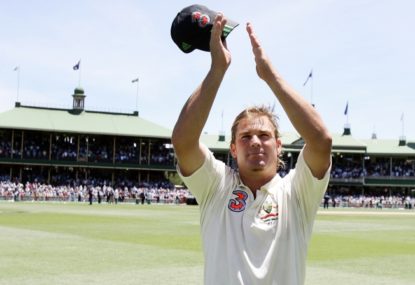MUST WATCH: JFM obliterates IPL bowling attack - even Bumrah! - for 15-ball 50... and keeps going
A six-laden, 27-ball 84 from Jake Fraser-McGurk to continue his outrageous debut IPL!

Warne and MacGill. The two names on the Australian team sheet that told you that the Australian Test schedule had reached the SCG in the early 2000s.
They played at home together for the last time against South Africa in the 2006 New Year’s Test. Coincidentally, it was the last time Australia won a Test at home without taking ten wickets in either innings.
I came to thinking about their partnership when I read a preview in which Stephen O’Keefe was announced Nathan Lyon’s partner at the SCG for the third Test against the West Indies. The first spin twins for Australia at home in ten years.
Sociologist Robert F. Winch was, as far as I can find, the person to advance the theory that “opposites attract”. That theory wasn’t exactly true as far as Warne and MacGill was concerned. It wasn’t that they couldn’t bowl effectively in tandem, or that they weren’t opposites, but Warne was more effective when he was partnered with Tim May.
One example of where that led to a strange decision was when MacGill was omitted from the 2004 Indian tour squad in favour of Nathan Hauritz.
Warne, although not a big drinker, preferred beer; MacGill preferred wine, although both learned to enjoy beer and wine. But the point is beer and wine don’t mix. At best, they coexist uneasily, as Gideon Haigh once described Warne and MacGill’s partnership.
Warne’s best performance with MacGill in the side came at the Adelaide Oval against the West Indies in 2005 when he took 6-80 in the second innings. What’s notable about that performance is three things. One, the match was on even keel right from the start of the innings. Two, Brian Lara, on the back of 226, loomed ominously. Three, five of Warne’s six wickets came in partnership with Glenn McGrath and Brett Lee, as he bowled 33 overs to MacGill’s 11.
That situation was geared towards Warne being the spinner, not being one of the spinners.
Unsurprisingly, MacGill only won once when he and Warne were competing for the same spot, in Antigua in 1999. But at least he only had to face Shane Warne the cricketer when he was competing for a spot. Each one of the many spinners tried after Warne’s retirement have had to face being compared to Warne’s stats, his legend, and that would have been a ridiculous challenge for anyone.
Two of those other options were Michael Beer and Steve Smith. They were tried together in tandem once in a SCG Test in 2011. Smith wasn’t a specialist leg spinner, even then, so they weren’t two spin twins. Nathan Hauritz was a more proven Test option – heck, even Michael Clarke was a better option. But Hauritz suffered from the notion that there simply had to be someone better, even after four Ashes Tests had proved that there wasn’t.
So in that sense, MacGill was luckier that he had been born in Warne’s time than if he had been born immediately afterwards. He acknowledged Warne’s greatness, and bowled well on the limited occasions he bowled with Warne. It maximised the ratio of favourable spinning pitches he bowled on in his Test career.
But MacGill was unlucky. If Australia had had a consistent all-rounder at Test level during the majority of both he and Warne’s careers, he probably would have played more.
Scarcities were rare during Australia’s Golden Era. The only two were the lack of a high-class finger spinner and an all-rounder. Australia had both of those before 1995, in Tim May and Steve Waugh.
But May’s last Test was before Australia’s landmark win in the West Indies in 1995. After 1994, Waugh would never take more than six Test wickets in a calendar year again. He would establish his profile as a great batsman, but by 1998, when MacGill made his debut, his bowling contribution had already become less and less.
What I do know is that Warne and MacGill were intriguing to watch and worth the price of admission. Differences can be overplayed, and there were more similarities between the two than what some believed.
After all, there’s a time and a place for beer and wine.